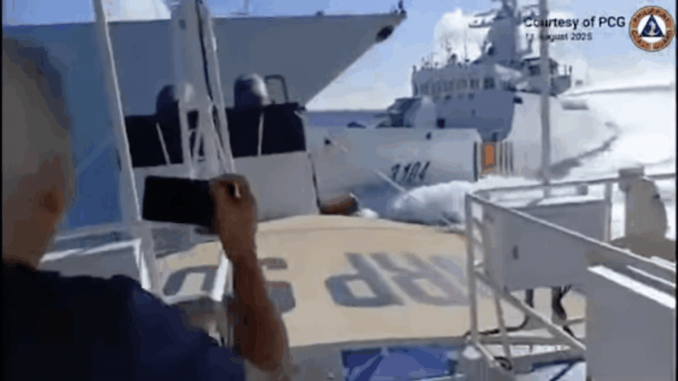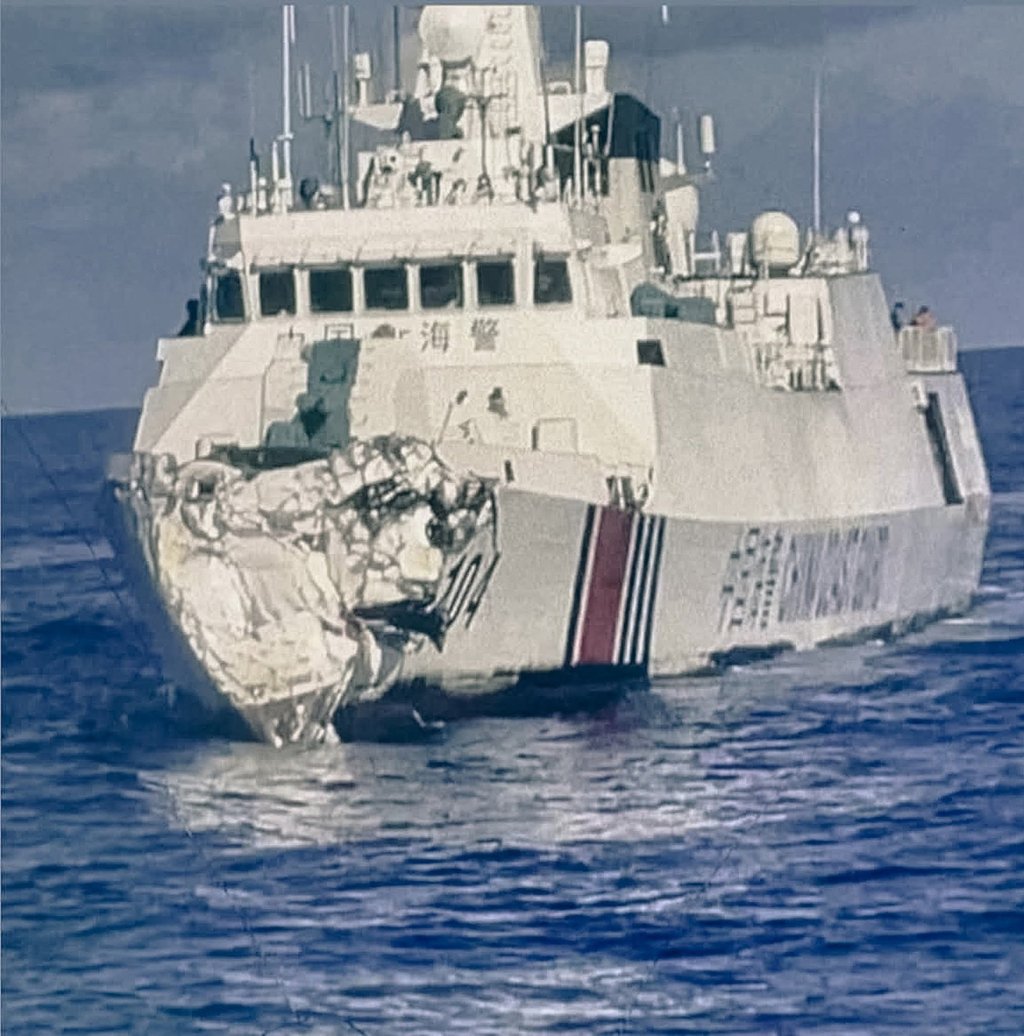
| Published August 12, 2025
In the latest South China Sea flare-up, PLA Navy and coastguard vessels appear to collide in video during encounter with Philippine boat
MANILA / WEST PHILIPPINE SEA – August 11, 2025 — In a rare and dramatic turn of events, a China Coast Guard (CCG) vessel, tailing the Philippine Coast Guard (PCG) ship BRP Suluan, collided with a People’s Liberation Army (PLA) Navy warship during a high-speed pursuit near Scarborough (Panatag) Shoal — a deeply contested feature in the South China Sea.
The Incident Unfolds
-
What began as another tense day in the contested waters of the West Philippine Sea quickly turned into a rare and dramatic mishap for the Chinese maritime forces.
-
The confrontation started when a Chinese Coast Guard vessel, identified by its hull number 3104, attempted to block the path of the Philippine Coast Guard’s BRP Suluan near Scarborough Shoal. At close range, the Chinese ship unleashed powerful water cannon bursts aimed at forcing the Philippine vessel to change course.
-
The BRP Suluan’s crew, trained for such encounters, executed evasive maneuvers that kept the vessel on its intended track while avoiding damage. Observers described the scene as a tense cat-and-mouse game, with the Philippine cutter maintaining composure under pressure.
-
As the chase escalated, 3104 accelerated to overtake the Philippine vessel on the starboard side. In the process, it crossed paths with a People’s Liberation Army Navy warship, hull number 164, which had also been maneuvering aggressively in the area.
-
A miscalculated turn brought the two Chinese ships into a collision, sending a loud metallic crash echoing across the waves. The Coast Guard vessel’s bow suffered extensive damage, reportedly breaching the hull and rendering it unseaworthy. The PLA warship sustained visible scrapes and dents, though it remained afloat and operational.
-
From the Philippine deck, cameras rolled. Within hours, the footage was shared publicly, showing the dramatic moment when the two Chinese ships slammed into each other while in pursuit — a visual narrative that Manila was quick to use as evidence of unsafe and unprofessional maneuvers in contested waters.
-
According to maritime security experts, the incident highlights the inherent risks of operating multiple vessels at high speed in tight quarters, especially in politically charged zones where each side is determined to project control.
-
Philippine Response and Diplomatic Fallout
-
The Philippines reacted swiftly, framing the incident as proof of Beijing’s aggressive and reckless tactics in the West Philippine Sea.
-
The Philippine Coast Guard invoked its obligations under international maritime law, particularly the duty to render assistance at sea. It offered medical aid, rescue operations, and any other necessary support for the crew of the damaged Chinese vessel — a move designed both to uphold humanitarian principles and to showcase professional conduct in stark contrast to China’s actions.
-
The Department of National Defense issued a strongly worded condemnation, describing the collision as “atrocious and inane behavior” that underscored the dangers of Chinese harassment in Philippine waters. Officials vowed that the nation would “never be oppressed,” signaling a firm policy stance despite rising tensions.
-
President Ferdinand Marcos Jr. reaffirmed that Philippine vessels will continue operating near Scarborough Shoal and that there are no plans to withdraw from traditional fishing grounds. He stressed that Filipino presence in these areas is both a matter of sovereignty and livelihood security for coastal communities.
-
Legislative leaders joined in the chorus of criticism. Some pointedly remarked that the incident was a case of China “reaping what it sowed,” while others called for increased support to Filipino fishermen to ensure continued access to contested waters.
-
Analysts noted that Manila’s decision to publicly release video footage of the collision was a strategic move aimed at countering Beijing’s narrative, rallying domestic unity, and reinforcing international sympathy for the Philippine position.
In the broader diplomatic arena, the collision has added momentum to calls for stronger regional security cooperation and more robust maritime patrols with allied nations, as Manila seeks to push back against persistent Chinese incursions without escalating into open conflict.
-
China’s Reaction
-
Beijing’s official response was measured but noticeably avoided addressing the embarrassment of two of its own vessels colliding.
-
The Chinese Coast Guard released a statement insisting that its actions near Scarborough Shoal were “lawful, professional, and restrained”, portraying the incident as part of routine enforcement to safeguard what it calls “China’s sovereign rights” in the area. There was no acknowledgement of the collision or damage to its ships, suggesting an effort to downplay the event domestically.
-
State media coverage inside China largely omitted details of the accident, focusing instead on claims that Chinese units had “expelled Philippine vessels” from what Beijing terms Huangyan Dao. This framing mirrors previous incidents, where China emphasizes sovereignty enforcement rather than maritime mishaps.
-
The People’s Liberation Army Navy did not issue a direct statement, but regional analysts note that the collision involving a PLA warship is unusual and potentially embarrassing, especially given Beijing’s push to project naval competence.
-
Diplomatic sources reiterated that Scarborough Shoal falls under China’s jurisdiction, and that actions taken were “necessary and legitimate” to maintain order. However, there was still no official explanation for how two ships from the same side collided during an operation.
-
Chinese officials framed the outcome as a successful enforcement action, glossing over the mishap and instead highlighting that the Philippine vessel was “driven away.”
This tight-lipped approach reflects a familiar Chinese pattern: emphasize control, minimize operational errors, and maintain a narrative of dominance in contested waters — even when events at sea tell a more complicated story.
-

A Chinese coastguard vessel is pictured on Monday in the South China Sea after an apparent collision with another Chinese ship. Photo: Philippine Coast Guard
 Implications
Implications
The collision near Scarborough Shoal is more than just a maritime mishap — it is a symbol of the volatile dynamics in one of the most contested stretches of water in the world.
-
Erosion of China’s Image at Sea – Beijing has invested heavily in portraying its naval and coast guard forces as disciplined, modern, and capable. The sight of two of its own vessels colliding during an enforcement mission undermines that image, particularly in the eyes of neighboring countries and the international maritime community.
-
Strengthening Manila’s Narrative – For the Philippines, the incident offers a rare opportunity to showcase professionalism and restraint in the face of provocation. The prompt offer of assistance to the damaged Chinese ship reinforces the contrast between Manila’s conduct and Beijing’s more aggressive tactics.
-
Potential Diplomatic Ripple Effects – Allies and partners may interpret the collision as further proof of China’s high-risk behavior in disputed waters. This could accelerate joint patrols, intelligence sharing, and defense cooperation between the Philippines and countries such as the United States, Japan, and Australia.
-
Impact on Fishermen and Local Communities – While the clash did not involve civilian vessels directly, it highlights the precarious situation for Filipino fishermen who depend on access to Scarborough Shoal. Tensions of this kind often lead to tighter Chinese blockades, which can squeeze livelihoods.
-
Risk of Escalation Through Miscalculation – The incident is a reminder that in crowded maritime flashpoints, even a single navigational error or overzealous maneuver can spiral into a broader confrontation. With both sides unwilling to yield, the chance of more dangerous encounters in the future remains high.
In the broader context, this event underscores how maritime disputes in the West Philippine Sea are no longer abstract diplomatic issues — they are real-time, high-stakes confrontations playing out on the waves, with implications for regional stability and the global balance of power.
 Overall Takeaway:
Overall Takeaway:
The collision between two Chinese vessels off Scarborough Shoal will be remembered not only as a rare operational blunder, but also as a telling moment in the ongoing struggle for control of the West Philippine Sea. For the Philippines, it served as both a vindication of its resilience and an opportunity to rally domestic and international support. For China, it was an unwelcome reminder that projecting dominance in contested waters carries both political and practical risks.
As tensions persist, the shoal remains a microcosm of the larger regional dispute — a place where national pride, economic interests, and strategic ambitions converge. In such a setting, even a split-second miscalculation can have consequences far beyond the immediate horizon. Whether this incident will cool tempers or harden positions remains to be seen, but one fact is clear: Scarborough Shoal will continue to test the resolve, skill, and judgment of all who navigate its waters.
SOURCES: INQUIRER.NET – Chinese ships collide off Scarborough Shoal; PH Coast Guard offers aid
MANILA BULLETIN – DND blasts China after collision in WPS: ‘We shall never be oppressed’
BUSINESS INSIDER – Chinese ships slam into one another during a South China Sea chase, Philippine Coast Guard video shows
SOUTH CHINA MORNING POST – Chinese ships collide during clash with Philippine vessel at contested Scarborough Shoal





Be the first to comment